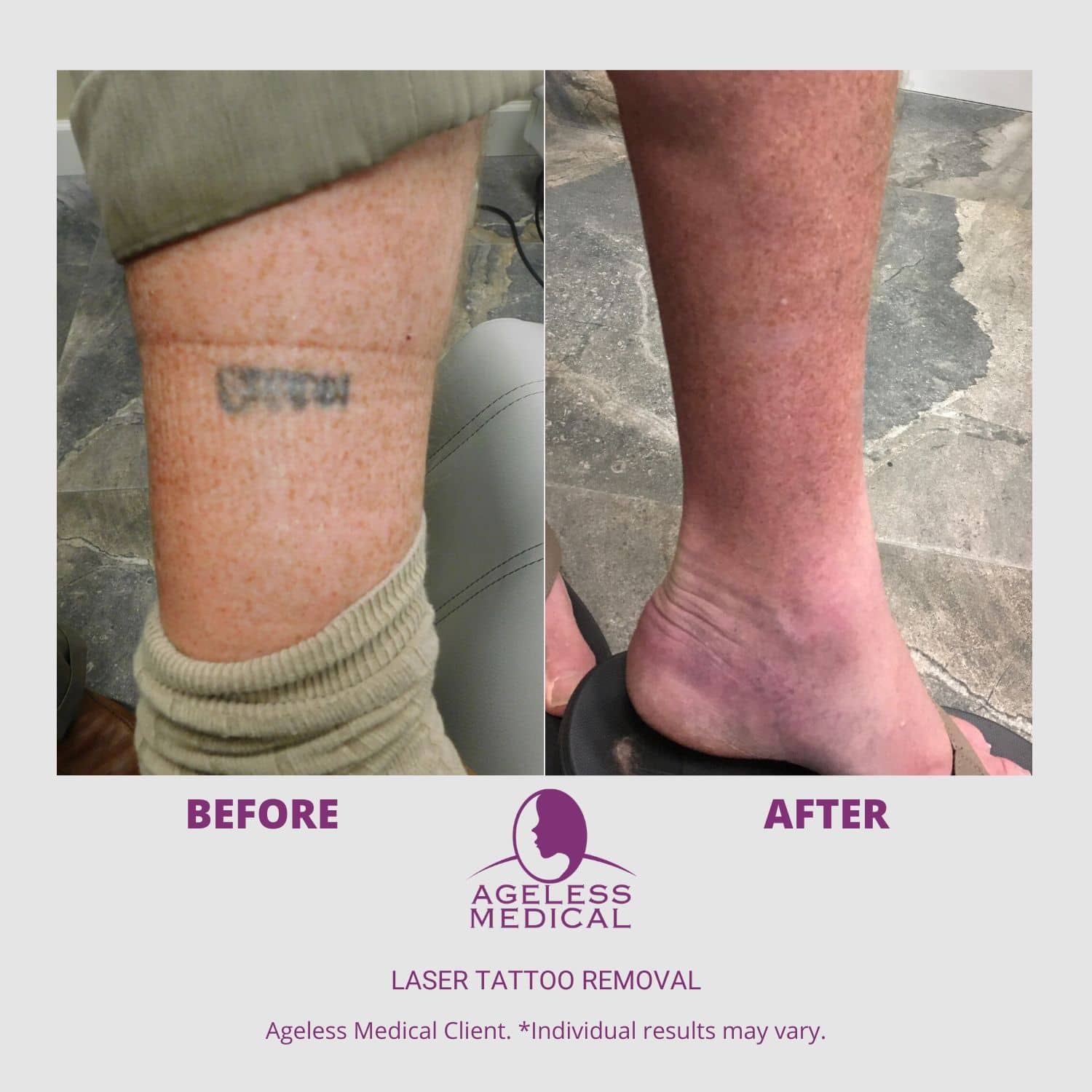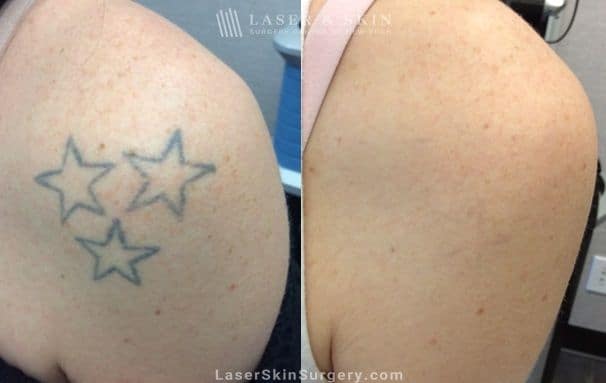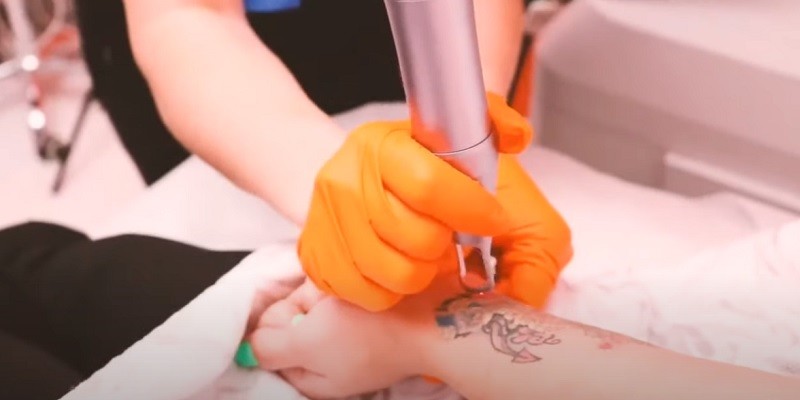Last Updated on June 18, 2025 by Jaclyn A. Neeley
Tattoo removal can leave scars, although it is not a common occurrence. Scarring is more likely to happen in individuals with darker skin tones due to a loss of pigmentation.
However, over time, the pigmentation may return and the scars may become less visible.

Credit: www.agelessmed.com
Tattoo Removal
When it comes to tattoo removal, one of the most common questions people have is whether it leaves scars. While most individuals find that there is little to no scarring from the process, it is important to understand that it can happen, especially in those with darker skin tones. Scarring may occur due to a loss of pigmentation, but this is usually temporary and will become less visible over time.
How Does Laser Tattoo Removal Work?
Laser tattoo removal works by using high-intensity laser beams to break down the tattoo ink particles into smaller fragments. These smaller fragments are then naturally eliminated by the body’s immune system over time. The laser targets the pigments in the tattoo ink without causing damage to the surrounding skin.
Read More – How Bad Do Shin Tattoos Hurt?
What Type Of Laser Is Used For Laser Tattoo Removal?
The most common type of laser used for tattoo removal is the Q-switched laser. This type of laser produces short, high-energy pulses that are able to effectively target and remove tattoo ink. The specific wavelength of the laser is adjusted based on the colors of the tattoo ink being treated.
Who Is The Ideal Candidate For Laser Tattoo Removal?
The ideal candidate for laser tattoo removal is someone who is in good overall health and has realistic expectations about the process. It is important to note that laser tattoo removal may be less effective for individuals with certain skin tones or tattoo colors. Consulting with a qualified professional will help determine if laser tattoo removal is suitable for you.
What Colors Of Ink Are The Most Difficult To Remove?
The difficulty of removing tattoo ink depends on various factors, including the colors used. Generally, darker colors such as black, dark blue, and green are more easily targeted and removed by laser. On the other hand, lighter colors like yellow, pink, and white can be more challenging to eliminate completely. Multiple sessions may be required to achieve the desired results for tattoos with difficult-to-remove colors.

Credit: www.laserskinsurgery.com
Does Tattoo Removal Leave Scars?
When it comes to tattoo removal, one common concern is whether it will leave scars. Many people who regret their tattoos are hesitant to undergo the removal process due to the fear of being left with unsightly scars. In this article, we will address this concern and explore whether tattoo removal leaves scars or not.
What Does A Tattoo Removal Scar Look Like?
Usually, the scarring caused by tattoo removal is faint and hard to notice unless you look closely. In some rare cases, clients may experience hypopigmentation, which means the skin where the tattoo used to be is lighter than the surrounding skin. However, these scars often fade over time and become less noticeable.
Can A Tattoo Be Completely Removed?
Yes, tattoos can be completely removed through laser treatments or surgery. Laser tattoo removal is a popular option as it is relatively less invasive and provides effective results. However, the complete removal of a tattoo may require multiple sessions, depending on factors such as the size, color, and depth of the tattoo.
It’s important to note that certain colors of ink, especially bright and vibrant ones, may be more difficult to remove completely. However, advancements in laser technology have made it possible to achieve significant fading, if not complete removal, of tattoos.
Do Removed Tattoos Fully Heal?
After tattoo removal, the treated area will undergo a healing process. Typically, the skin will scab and peel, similar to the healing process after getting a tattoo. It’s crucial to follow the post-treatment care instructions provided by your tattoo removal specialist to ensure proper healing and minimize the risk of complications.
With proper aftercare, the skin will eventually heal, and any scarring or hypopigmentation will improve over time. Most individuals find that there is little to no scarring from the tattoo removal process.
While there is a possibility of some scarring or hypopigmentation after tattoo removal, it is generally minimal and fades over time. Laser tattoo removal and surgery can effectively remove tattoos with minimal scarring, allowing individuals to have a clean canvas once again.
Read More – What Does Cherry Tattoo Mean?
Minimizing Scarring
Tattoo removal can sometimes result in scarring, especially for those with darker skin tones. However, these scars are usually faint and become less visible over time as the skin’s pigmentation returns. Laser tattoo removal is an effective option for minimizing scarring.
What Steps Can Be Taken To Prevent Scarring?
To minimize scarring during tattoo removal, there are several steps that can be taken:
1. Choose a reputable clinic: Make sure to select a professional and experienced clinic for your tattoo removal. A skilled technician will have a better understanding of the laser settings required for your specific tattoo and skin type, minimizing the risk of scarring.
2. Follow proper aftercare instructions: Your tattoo removal technician will provide you with detailed aftercare instructions. It is crucial to follow these instructions carefully to promote proper healing and minimize scarring. This may include keeping the treated area clean, applying antibiotic ointment, and keeping it covered with a sterile dressing.
3. Avoid sun exposure: Exposure to the sun’s harmful UV rays can increase the risk of scarring. Protect the treated area from direct sunlight by wearing protective clothing or using sunscreen with a high SPF.
4. Stay hydrated and eat a healthy diet: Proper hydration and a healthy diet can improve your skin’s overall health, aiding in the healing process and reducing the chances of scarring.
5. Consider using silicone gel or sheets: Silicone gel or sheets can help flatten and soften the scar tissue, reducing its appearance. Discuss this option with your tattoo removal technician or dermatologist.
Post-treatment Care
After each laser tattoo removal session, it is important to follow these post-treatment care tips to minimize scarring and promote proper healing:
1. Keep the treated area clean: Gently cleanse the area with mild soap and water, avoiding excessive rubbing or scrubbing.
2. Avoid picking or scratching: Itching may occur during the healing process, but scratching or picking at the treated area can increase the risk of scarring. If necessary, apply a cold compress or anti-itch cream to alleviate any discomfort.
3. Avoid exposing the area to excessive heat: Hot showers, saunas, steam rooms, and hot tubs should be avoided for at least 48 hours after the treatment.
4. Avoid strenuous activities: Refrain from activities that may cause excessive sweating or friction on the treated area, as this can irritate the skin and delay the healing process.
5. Apply recommended ointments or creams: Your tattoo removal technician may suggest applying a prescribed ointment or cream to the treated area to aid in healing and minimize scarring. Follow their instructions carefully.
Is Laser Tattoo Removal Painful?
During laser tattoo removal, most individuals experience some level of discomfort. The sensation is often described as similar to a rubber band snapping against the skin. However, the pain can vary depending on the individual’s pain tolerance and the location of the tattoo.
To minimize discomfort during the procedure, a topical numbing cream or local anesthesia may be applied. Cooling techniques such as ice packs or a cold air blower can also help alleviate pain and reduce any potential discomfort.
Read More – What Does A Crow Tattoo Mean?
What Are The Risks Of Laser Tattoo Removal?
While laser tattoo removal is generally considered safe and effective, there are some potential risks and side effects to be aware of:
1. Scarring: Although uncommon, scarring can occur as a result of laser tattoo removal. Proper aftercare and choosing a reputable clinic can minimize this risk.
2. Hyperpigmentation or hypopigmentation: Changes in skin pigmentation can occur after laser tattoo removal. Hyperpigmentation is the darkening of the skin, while hypopigmentation is the lightening of the skin. These changes are usually temporary but can take several months to resolve.
3. Infection: If proper aftercare instructions are not followed, there is a risk of infection. It is important to keep the treated area clean, dry, and protected.
4. Blistering or swelling: Some individuals may experience blisters or swelling immediately after the treatment. This is typically a temporary side effect and will subside within a few days.
5. Allergic reactions: In rare cases, individuals may experience an allergic reaction to the tattoo ink or the laser treatment itself. It is important to inform your technician of any known allergies before the procedure.
It is essential to consult with a qualified tattoo removal specialist or dermatologist to discuss the potential risks and benefits of laser tattoo removal based on your individual circumstances.

Credit: www.pinterest.com
Frequently Asked Questions On Does Tattoo Removal Leave Scars?
Do Tattoo Removal Marks Go Away?
Tattoo removal marks may leave some scarring, especially in darker skin tones. However, the pigmentation loss and scarring usually fade over time and become less visible. Laser tattoo removal is generally effective and leaves minimal scarring compared to surgical methods.
Can A Tattoo Be Completely Removed?
Yes, tattoos can be completely removed by lasers or surgery. Laser removal may cause little to no scarring, but surgery will leave a scar. Scarring is more common in people with darker skin tones, but it will likely fade over time.
What Does A Tattoo Removal Scar Look Like?
Tattoo removal scars are usually faint and hard to notice, with rare cases of lighter skin where the tattoo used to be. Laser removal typically doesn’t cause scarring, but darker-skinned individuals may experience some pigmentation loss, which becomes less noticeable over time.
Do Removed Tattoos Fully Heal?
Tattoo removal can sometimes leave scars, especially for those with darker skin tones. However, over time, the scars may become less visible as pigmentation returns. Laser tattoo removal is a popular method that usually doesn’t result in scarring, but it’s expensive.
Surgery is another option, but it will leave a scar.
Can Tattoo Removal Leave Scars?
Though rare, tattoo removal can leave faint scarring or hypopigmentation, which lightens the surrounding skin.
Conclusion
Tattoo removal may leave scars, especially in individuals with darker skin tones, due to a loss of pigmentation. However, in most cases, the scarring is faint and not easily noticeable. Over time, the pigmentation may return, and the scars become less visible.
Laser tattoo removal is a commonly used method that usually does not result in scar formation. It is important to note that individual experiences may vary.







